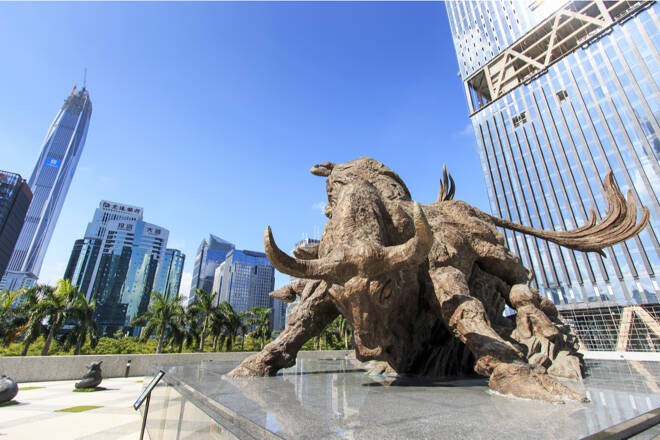Advertisement
Advertisement
Hang Seng Index, ASX 200, Nikkei 225: Futures Flash Green Pre US CPI Numbers
By:
Australian trade data will draw interest on Thursday. However, overnight gains from the US could support the Hang Seng Index and broader markets.
Highlights
- The Nikkei surged on easing bets on a Bank of Japan pivot, while the ASX 200 and Hang Seng Index ended the Wednesday session in negative territory.
- Overnight US equity market movements from Wednesday will set the tone for the Thursday Asian session.
- Trade data from Australia could influence market risk sentiment, with a likely focus on trade terms with China.
Overview of the Wednesday Session
On Wednesday, the Nikkei had a positive session. However, the ASX200 and Hang Seng Index ended the day in negative territory. Investor caution ahead of the US CPI Report and US bank earnings contributed to the losses.
On Tuesday, the Nasdaq Composite Index gained 0.09%, while the S&P 500 and Dow saw losses of 0.15% and 0.42%, respectively. The mixed session set the tone for the Wednesday Asian session.
However, economic indicators from Australia and Japan influenced the ASX 200 and the Nikkei.
Wage growth figures from Japan eased bets on a Bank of Japan pivot from negative rates. A stronger USD/JPY drove demand for export-orientated and tech stocks. Average cash earnings rose by 0.2% year-over-year in November after rising by 1.5% in October.
Softer inflation numbers from Australia eased bets on further RBA rate hikes. The Monthly CPI Indicator fell from 4.9% to 4.3% in November.
Australian Trade Data and US CPI Report Caution
On Thursday, US equity market movements from Wednesday could influence the Asian equity market session. There were no overnight US economic indicators from Wednesday to impact market risk sentiment.
However, AI-linked stocks delivered gains for the Nasdaq Composite Index. Market bets on a Q1 Fed rate hike delivered gains for the Dow and S&P 500. The Dow and S&P 500 rose by 0.45% and 0.57%, respectively, with the Nasdaq Composite Index ended the day up 0.75%.
On Thursday, investors must also consider Asian economic indicators. Australian trade data for November will garner investor interest. Economists expect the trade surplus to widen from A$7.129 billion to $7.500 billion. However, import and export figures and trade terms with China also need consideration.
Beyond the numbers, investors must monitor Bank of Japan commentary and stimulus chatter from Beijing.
In the futures markets, the ASX 200 and the Nikkei were up 13 and 410 points, respectively.
ASX 200
The ASX 200 declined by 0.69% on Wednesday. Tech stocks made gains, while oil, mining, gold, and bank stocks ended the day in negative territory. The S&P ASX All Technology Index (XTX) gained 0.44%.
Falling iron ore prices impacted mining stocks. Fortescue Metals Group Ltd. (FMG) declined by 1.78%. BHP Group Ltd (BHP) and Rio Tinto Ltd. (RIO) slid by 2.27% and 2.27%, respectively.
Gold (XAU/USD) and oil stocks ended the day in negative territory. Northern Star Resources Ltd. (NST) and Evolution Mining Ltd. (EVN) saw losses of 1.48% and 1.58%, respectively. Woodside Energy Group Ltd (WDS) and Santos Ltd (STO) ended the session down 0.71% and 0.92%, respectively.
The big four banks contributed to the losses. Commonwealth Bank of Australia (CBA) and Westpac Banking Corp. (WBC) fell by 0.87% and 0.61%, respectively. National Australia Bank Ltd. (NAB) and ANZ Group Holdings Ltd (ANZ) declined by 0.58% and 0.23%, respectively.
Hang Seng Index
The Hang Seng Index declined by 0.57% on Wednesday. The Hang Seng Tech Index (HSTECH) fell by 0.76%. Property stocks also ended the session in negative territory. The Hang Seng Mainland Properties Index (HSMPI) fell by 0.31%.
Alibaba (9988) and Tencent (0700) ended the day down 0.65% and 1.20%, respectively.
Bank stocks had a mixed session. HSBC (0005) fell by 0.87%. China Construction Bank (0939) and Industrial Commercial Bank (1398) ended the session flat.
The Nikkei 225
(Graph for reference purposes only)
The Nikkei rallied 2.01% on Wednesday.
Bank stocks made modest gains. Sumitomo Mitsui Financial Group Inc. (8316) and Mitsubishi UFJ Financial Group Inc. (8306) rose by 0.01% and 0.04%, respectively. However, it was a positive session for the main components of the Nikkei.
Fast Retailing Co. Ltd. (9983) and Sony Group Corp. (6758) surged by 3.86% and 3.82%, respectively. Tokyo Electron Ltd. (8035) and KDDI Corp. (9433) gained 1.91% and 1.28%, respectively. Softbank Group Corp. (9948) ended the day up 1.09%.
For upcoming economic events, check out our economic calendar.
About the Author
Bob Masonauthor
With over 28 years of experience in the financial industry, Bob has worked with various global rating agencies and multinational banks. Currently he is covering currencies, commodities, alternative asset classes and global equities, focusing mostly on European and Asian markets.
Advertisement
